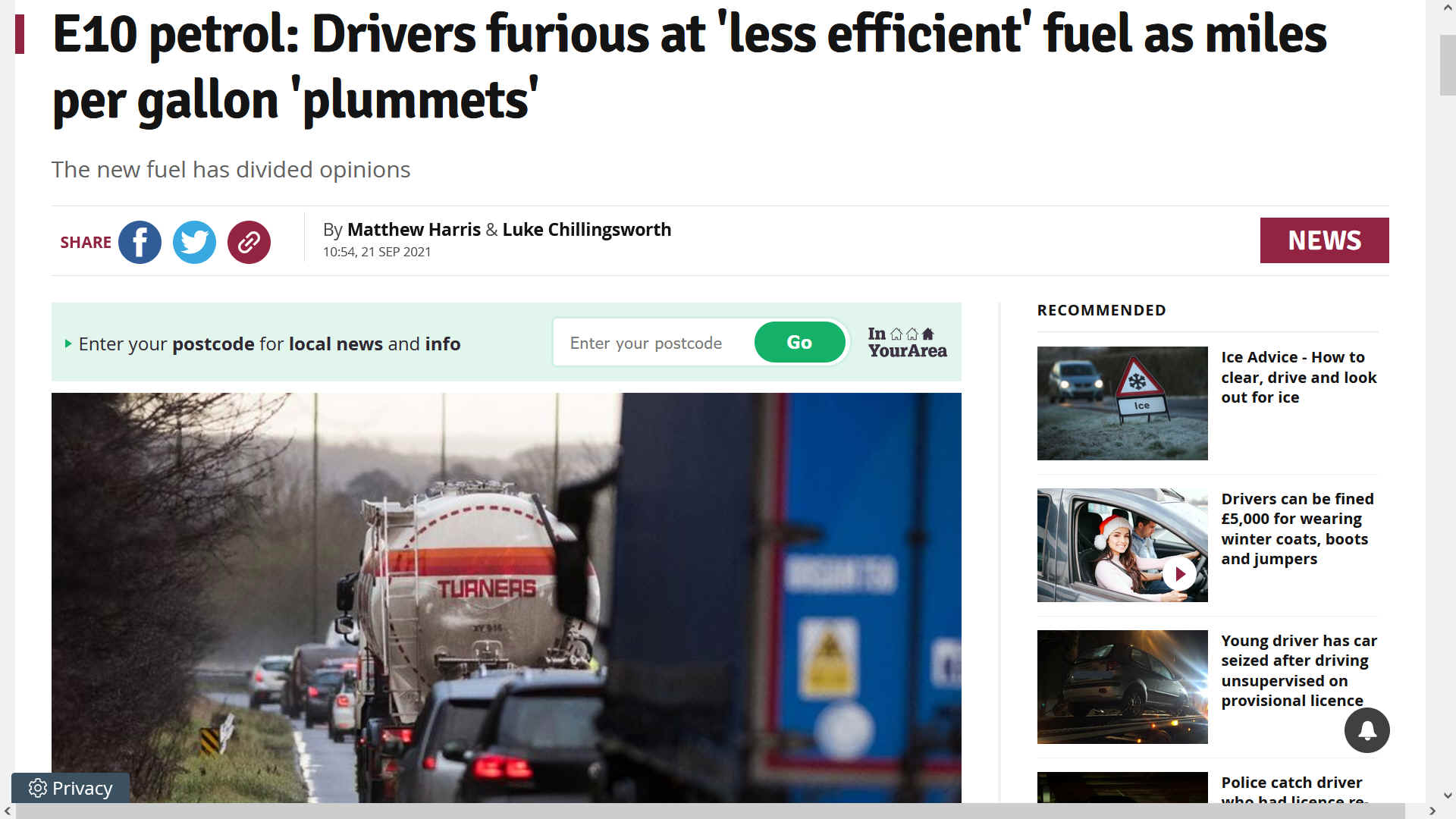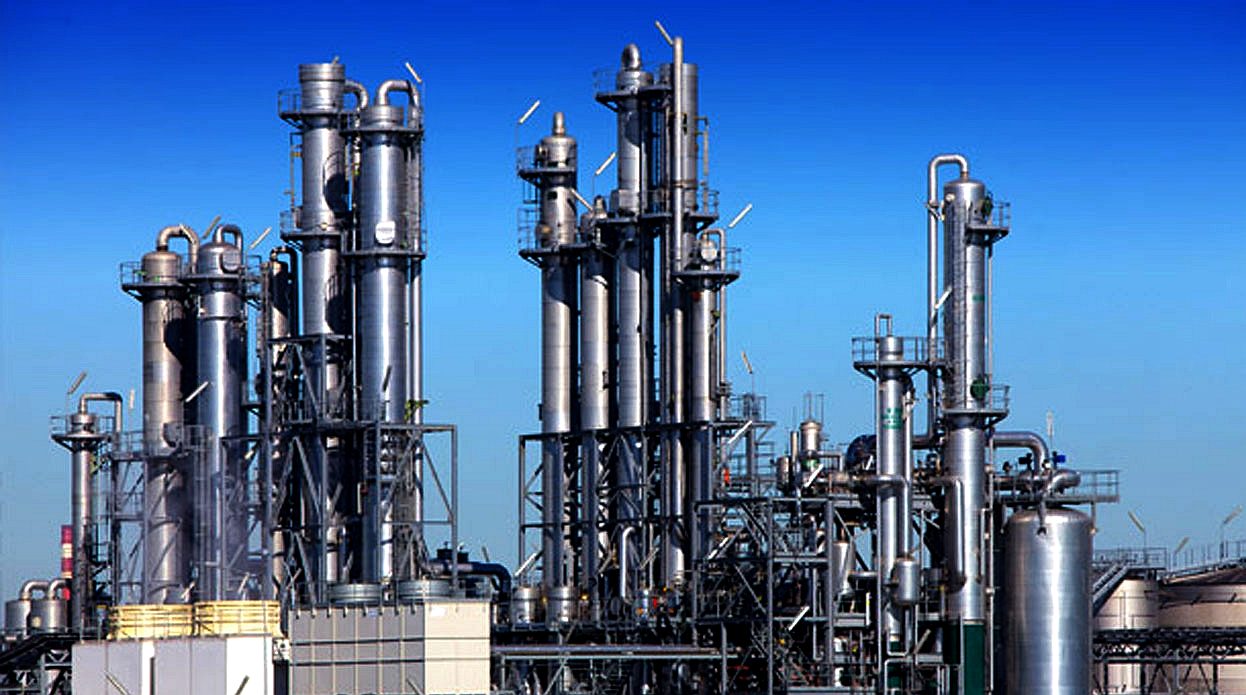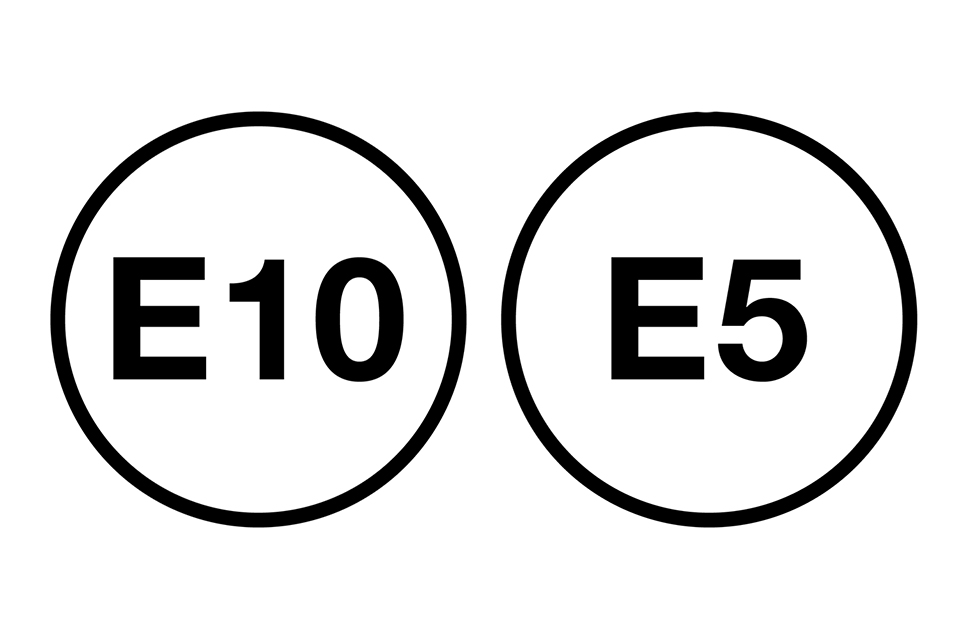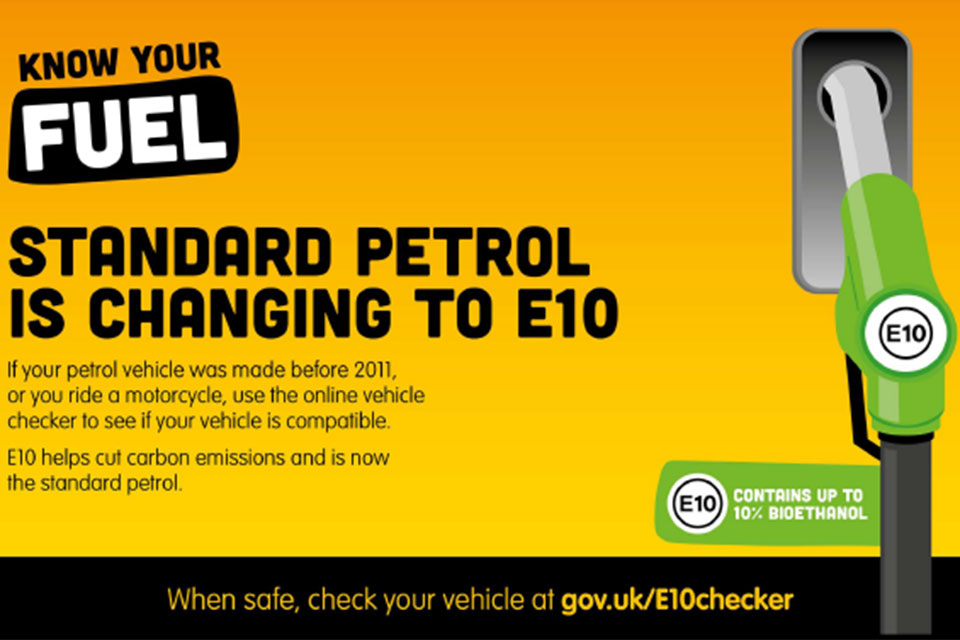|
E90/10%
- PETROL/ETHANOL
Please use our
A-Z
INDEX to navigate this
site where pages may link to other sites

DOUBLE
STANDARDS - Why waste money forcing infrastructure
revision for fossil fuel vehicles, when that same taxpayer and
energy company time and money could have been spent on EVs. It
does not make any sense. Especially, where using this fuel is
counterproductive in terms of genuine CO2 reductions, and may
exacerbate man
made famines.
Petroleum
is a fossil fuel that is used to power cars and vans using
internal combustion engines, sold as E5 and now E10 grades
of gasoline mixed with ethanol produced from crops, even where
there is a food shortage. It's a bit like the biomass
electricity generating station(s), counterproductive short
term fix thinking for cronies, more of a greenwashing
exercise. It is not sustainable in a circular
economy, more of an attempt to extend the use of petroleum
as a transport fuel.
IS
E10 A CON?
Petrol
blended with 10% ethanol was supposed to reduce emissions from car
exhausts, but that may not have worked quite as Grant Shapps
and George Eustice had led us to believe.
And such use that competes with land for crops, with
815,000,000 million people undernourished, may be seen as
immoral in UN terms, apart from the extra cost in losing fuel efficiency.
Some are saying it is a ruse to rid the roads of older
vehicles and raise revenue on new car sales, putting extra
pressure on young working families who cannot afford an
electric vehicle. For sure motoring
costs will rise as you need more gallons to do less miles,
hence more money for the Treasury. All in all, it's a con. An
expensive con if you drive a classic. The money used on
changing the infrastructure, could have been spent on EV
refueling, including being hydrogen ready.

GOVERNMENT.UK VERSION OF THE TRUTH
During summer 2021, the standard (95 octane) petrol grade in Great Britain will become E10. In Northern Ireland, this will happen in early 2022.
The change in fuel applies to petrol only. Diesel fuel will not be changing.
Almost all (95%) petrol-powered vehicles on the road today can use E10 petrol and all cars built since 2011 are compatible.
If your petrol vehicle or equipment is not compatible with E10 fuel, you will still be able to use E5 by purchasing the ‘super’ grade (97+ octane) petrol from most filling stations.
Petrol pumps will clearly label petrol as either E10 or E5.
About E10 petrol
E10 petrol contains up to 10% renewable ethanol, which will help to reduce carbon dioxide (CO2) emissions associated with petrol vehicles and tackle
climate change. Petrol in the UK currently contains up to 5% renewable ethanol (known as E5).
E10 petrol is already widely used around the world, including across
Europe, the
US and
Australia. It has also been the reference fuel against which new cars are tested for emissions and performance since 2016.
Reducing emissions
CO2 is one of the greenhouse gases that contribute to climate change and the main benefit of E10 petrol is that it reduces overall levels of CO2-based vehicle emissions.
By blending petrol with up to 10% renewable ethanol, less fossil fuel is needed, helping us reduce carbon emissions and meet climate change targets.
The introduction of E10 petrol at UK forecourts could cut transport CO2 emissions by 750,000 tonnes a year – the equivalent of taking 350,000 cars off the road, or all the cars in North Yorkshire.
Renewable fuel blends, such as E10 petrol, are generally introduced to reduce overall
CO2 emissions. They have little impact on emissions associated with air quality and public health.
The production of renewable ethanol for blending with fossil petrol also results in valuable by-products, including animal feed and stored CO2.
Fuel economy
Using E10 petrol can slightly reduce fuel economy (the number of miles you are able to drive on a gallon of fuel). You may see a reduction of around 1%, but it is unlikely to be noticeable in everyday driving.
Other factors – such as your driving style or driving with under-inflated tyres or a roof rack – have a much more significant impact on fuel economy than using E10 petrol.
Compatibility
Around 95% of petrol-powered vehicles on the road are compatible with E10 petrol and this figure is increasing all the time.
All new cars manufactured since 2011 are compatible with E10 petrol, and
most cars and motorcycles manufactured since the late 1990s are also approved by manufacturers to use E10.
The following vehicles, however, may not be compatible with E10 petrol:
- classic, cherished and older vehicles
- some specific models, particularly those from the early 2000s
- some mopeds, particularly those with an engine size of 50cc or under
You can check whether your vehicle is approved to use E10 petrol using
the government's E10 vehicle checker, which covers cars, motorcycles and mopeds.
START NOW
https://www.gov.uk/check-vehicle-e10-petrol
If your brand or model is not listed, consult your manual or contact your vehicle or equipment manufacturer. Vehicle MOT garages or workshops may also be able to advise on cars, vans and motorcycles. If in doubt, continue to use E5 (97+ octane) petrol.
Classic vehicles
Many manufactures of classic cars are not listed in the vehicle checker. Where older brands are no longer trading, we cannot provide specific information on vehicle compatibility.
Owners of vehicles not listed in the vehicle checker should continue to use E5 (97+ octane) petrol, which will remain available in the ‘super’ grade.
For further information, we recommend contacting classic vehicle owners’ clubs and associations, as well as garages that may be able to provide advice.
What to do if your vehicle is not compatible with E10 petrol
Continue to use E5 petrol in the ‘super’ grade (97+ octane), which will remain available at many larger filling stations. Make sure you check the label before you fill up.
What to do if you put E10 petrol in a non-compatible vehicle
Simply fill up with E5 (‘97+ octane) petrol next time.
Using a single tank of E10 petrol in a vehicle that is not compatible should not be a major problem. Just make sure you fill up with the correct E5 (‘97+ octane) petrol grade next time.
Unlike putting petrol into a diesel engine, you shouldn’t need to drain the tank. On a one-time basis, your vehicle will not suffer engine damage as a result. Prolonged use of E10 petrol in a non-compatible vehicle, however, may cause harm and is not recommended.
Mixing E10 and E5 petrol
If your vehicle is compatible with E10 petrol, there’s no reason you can’t mix the 2 grades of petrol (E5 97+ and E10 95+). It’s perfectly safe to mix them in the same tank or fill up with E5 if E10 is not available.
Boats, aircraft and other petrol-powered equipment
Some other petrol-powered equipment may not be compatible with E10 petrol including:
- boats
- petrol-powered garden equipment or machinery, such as lawnmowers and chainsaws
Owners and operators should check their manual or ask the manufacturer or dealer before using E10.
Owners of light aircraft that currently use E5 petrol known as MOGAS should continue to use E5 petrol unless expressly approved by their manufacturer or regulating body.
Availability
E10 is becoming the standard petrol grade in Great Britain, meaning E10 petrol will be available at almost all petrol stations across England, Scotland and Wales.
In Northern Ireland, we expect the introduction to happen in early 2022, subject to legislative approval.
Petrol stations that offer 2 grades of petrol will stock E10 (95 octane) and E5 (97+ octane) petrol.
E5 (97+ octane petrol with no more than 5% renewable ethanol), however, will remain available at filling stations that sell 2 grades of petrol.
Some rural, remote or very small filling stations may sell only either E5 or E10 petrol as standard.
Labelling
At the filling station
At the petrol station, a circular ‘E10’ or ‘E5’ label will be clearly visible on both the petrol dispenser and nozzle, making it easy for you to identify the correct petrol to use.
The ‘E10’ and ‘E5’ labels look like this on your
vehicle:

New vehicles manufactured from 2019 onwards should have an ‘E10’ and ‘E5’ label close to the filler cap showing the fuel(s) they can use.
If you’re still unsure, consult your manual or contact the vehicle manufacturer. Or
write to your MP for advice.
TOP GEAR VERSION: What is E10 petrol?
It’s a blend of ethanol and petrol, with the ‘E10’ part referring to the maximum amount of ethanol allowed in the mix – 10 per cent. It’s far from the only standard for mixing drunk sauce and dino juice, with countries all over the world using blends from four to 95 per cent.
The blends differ due to differing legislation in various countries, as you’d expect, but it’s also based on supply of ethanol-producing crops. So Brazil, with acres upon acres of sugarcane, runs higher ethanol-petrol blends, and even uses 100 per cent booze in some cars. America leverages its huge corn crops to make delicious cornbread and much less delicious ethanol-blended petrol.
Really, do not drink petrol. Or straight ethanol, for that matter.
Why use E10 petrol?
There are a few reasons. The original idea is to supplement regular petrol so we use less of it; the other is to do with carbon dioxide emissions.
The US of A is quite fond of blending ethanol with its petrol, supplementing the fossil-based fuel with some farm-fresh booze in order to reduce its dependence on foreign oil. But that’s America, where farm subsidies prop up corn production to the point that they use it as a sweetener instead of sugar. And for making each drop of petrol go further – handy when you’re driving a Yank-spec behemoth.
The other argument is to reduce carbon emissions. The idea is that ethanol has less carbon than petrol – just two carbon atoms per molecule to petrol’s average of eight – so burning it will release less carbon dioxide. And that’s perfectly reasonable science. But that really only tells a little bit of the story.
Compared to petrol, ethanol has a lower energy density. Think of it like the difference between a salad sandwich and a donut. Both are food, but one has a lot more energy per bite, and also goes much better with a cup of coffee. But that might be beside the point.
In an engine, burning a less energy-dense fuel means that you need to burn more of it to get the same amount of power. This doesn’t mean that you’ll lose power if you use E10; rather that your fuel economy will drop as your car’s engine computer fiddles with fuel-air ratios to get the best stoichiometry (a fancy-pants term for the ideal mixture). So while the carbon count goes down with ethanol-blended petrol, fuel consumption goes up.
The question of whether that negates the point entirely is one that we’re not touching with a barge pole, because – much like almost any argument these days – it gets really political, really quickly, and then descends into ad hominem attacks until we lose what little faith we still have in humanity. Suffice to say that the lower fuel economy certainly mitigates the benefits to some extent.
Are there any problems using E10?
Apart from what we’ve already mentioned in terms of fuel economy, you can run into issues depending on the kind of car you drive. If you drive an electric car, for instance, you’ll find that it runs exceptionally poorly if filled up with E10 petrol. Or regular petrol, for that matter.
Generally speaking, most modern cars that run on 95 octane fuel today will run on 95 octane E10 fuel tomorrow without the slightest hiccup. As we said before, sensors will figure out the quality of the fuel, the engine computer will make an on-the-fly adjustment to fuel-air mixtures and so on, and you’ll drive along none the wiser.
With that said, ethanol is hygroscopic, which is a pocket-protector way of saying that it readily takes up water. In fact, if you poured 50mL of pure ethanol into a glass and then added 50mL of pure, distilled water, you’d only end up with about 96mL of solution (and a pretty rubbish cocktail), due to the fact that water and ethanol get in close and form bonds, much like people do after exposure to ethanol.
The problem for your car is that water – outside of your radiator and wiper bottle – is generally a bad thing, rusting and corroding delicate fuel system and engine parts that were never designed to come anywhere near water. And if you drive infrequently, extra ethanol in your tank will absorb extra water from the atmosphere and separate the fuel into straight petrol and an alcohol-water mix. The ethanol-water mix will sink to the bottom of the tank, and then, if you ever run low on petrol, you’ll pump water-diluted alcohol into your engine. And no one likes watered down booze.
Alcohol itself is no great friend to engines, either. If you cast your mind back to the 24 Hour Britcar race on Top Gear TV, you’ll remember all the issues the team had with the alcohol content in their farm-fresh biodiesel – the methanol that was used to make the fuel ate the seals in the fuel pump, then the fuel lines themselves.
On the other hand, if you have a car where the fuel tank, pump and lines (and a few other things besides) are made for ethanol blends, you’re laughing.
Is E10 petrol more expensive?
Not generally, no. Australia’s had E10 fuel for years, and it’s reliably been the cheapest option at the bowser since then – despite having a higher octane rating than the cheapest straight petrol option.
And as it’s replacing the standard 95-octane petrol that’s currently available in the UK – which already contains up to five per cent ethanol – it’ll likely remain the cheapest option at the pump. With that said, E10 petrol has less energy per litre than E5 or petrol with no ethanol, so, like we said, your car will almost certainly burn more of it. Which then means you have to fill up more often. So it’ll probably end up costing more, by dint of the fact that you’ll have to use more.
Is my car compatible with E10 petrol?
Generally, yes. Ethanol-petrol blends have grown in popularity over the past two decades, and anything made after 2011 should (what a wonderful caveat that is) accept E10 without worry. For a great many manufacturers, that worry-free timeline extends back to the early Nineties and even mid-Eighties. For some manufacturers, it’s as simple as ‘anything with fuel injection’, due to ethanol’s tendency to trash carburettors in a number of un-fun ways.
To demystify things a bit, the UK government has a site where you can check if your car can handle E10 fuel... with the caveat that it “will not be liable for any damage to your vehicle as a result of you using this service”. So that’s reassuring. That said, you can still buy the pricier 98 octane dino-juice for at least the next five years, if you’d prefer to pay more to rest a bit easier.
If you ride a motorbike, be wary of ethanol blends. While most major manufacturers have taken steps to ensure E10 compatibility, other (and older) bikes, and some mopeds, won’t run properly, so you should stick to fuel with as little ethanol as possible. And, like cars, this goes double for anything with carburettors.
Bikes likely can run on E10, if you want to – or have to. But, given most motorcyclists tend to cherish their bike – and that bikes generally use hardly any fuel – we’re tipping most riders will stick with the good stuff.
Can I use petrol with more ethanol, like E25, E50 or E85?
Not unless your car specifically says so, no. In cars like these, generally known as flex-fuel vehicles, the engine, fuel system, exhaust, sensors and computers are all made (or adapted) to deal with high-ethanol fuel. Any bare metal or rubber is taken out of the fuel system, for instance, so the booze won’t corrode it, and the rate, flow and spacing of fuel injection changes. There’s lots more, but we’ll be here all week listing it.
There are benefits to high-ethanol fuels, if your car’s set up to take them. For instance, both the Koenigsegg Jesko and SSC Tuatara (among many others) make oodles more power on E85 than they do on regular fuel, because ethanol has a huge cooling effect and resists detonation (knocking, pinging, engine exploding). So the engine control unit can advance spark timing and so on to the point that’d completely lunch an engine running on regular petrol, resulting in a Tuatara that makes 400bhp more on E85 than it does on pump gas, as the Americans call it.
MIRROR INCOMPATIBLE CARS LIST:
https://www.mirror.co.uk/money/cars-wont-work-use-new-24887281
More tax on more gallons sold = fraud.

HAGERTY
Like a lot of so-called environmental legislation, the benefits weren’t clear cut. Even the government’s own Impact Assessment report said that “there are no clear consumer advantages to choosing E10 fuel” and also that its RTFO targets up to 2032 could be met without the introduction of E10.
Nevertheless, you’d have thought that adding bio ethanol to petrol at least saves the release of climate-changing carbon dioxide (CO2) greenhouse gas when fossil fuels are burned. And that’s true, though exactly how much it saves is the source of some debate. In 2019, the UK government’s own figures claimed that the 1,400 million litres of fuel equivalent saved about 82 per cent of CO2, but that figure fell to 78 per cent when indirect land use change was taken into account.
It’s more complicated than that, however, since crops have to be grown, tended, harvested, dried, fermented, distilled and burned, which requires resources – land, energy and lots of water.
Energy balance is the figure for the energy invested against the energy harvested and studies have shown the energy balance of US corn-derived ethanol to be as little as 1.3, with
Brazil’s sugar-cane-derived ethanol having an energy balance of up to eight. In 2019 in the UK, imported corn-derived, bio ethanol feedstock accounted for 31 per cent of the bio ethanol burned and 10 per cent of the total renewable fuel.
There is also evidence that while ethanol burns without significant particulate emissions, it adds to exhaust toxity which can be an issue in built-up areas. It’s also about a third less energy dense than pure petrol, which means if you burn it, according to the US Environmental Protection Agency, there’s between a three and four per cent reduction in fuel consumption compared with oil-based fuel.
Tests, however, have shown fuel consumption could increase by as much as 11 per cent, especially in small cars. When What Car? performed independent testing of the fuel consumption of family cars run on E10, they were found to guzzle more fuel, by between 9.8 per cent and 11.5 per cent. Even the government’s own research suggests that best-estimate costs to car owners using E10 could be a total of an extra £200 million in the first year alone.
There’s also the issue of biomass culture being substituted for
food production and a distinctly awkward question of the morality of growing food for our cars in a world where, according to UN Food and Agriculture Organization estimates, “there are about 815 million people in the world suffering from chronic undernourishment”.
And concerns have also been expressed about inter-government high-level sharp dealing in carbon credits and import tariffs, which could have the effect of bio ethanol being tankered around the world to massage renewable fuel figures – but they wouldn’t do that would they?
In Europe E10 fuel has been available for some years now, but it is sold alongside E5 with just five per cent ethanol, which has remained available at the pump and that’s what a lot of old car owners use.
So why isn’t this the case in the UK? The answer lies in the way the white paper was sneaked out in the middle of a
Covid lockdown with no publicity. The government said that the move could result in CO2 saving of up to 750,000 tonnes (though that figure was 700,000 tonnes in the first paper on this subject), or the equivalent of taking 350,000 cars off the road.
This was the result of negotiation with the seven bio-fuel retailers, one fuel retailer and 15 trade associations who replied to the original 2018 white paper along with 57 members of the public and a number of motoring organisations. Rather than offer a third grade of petrol, which was a popular idea with the public and the method used in Europe and North America, the industry put pressure for a seamless introduction (for them) so that E10 bio ethanol mix would become the new ‘standard’ premium fuel with an octane rating of 95 Ron min, with what we now know as super unleaded (octane rating 97 Ron min) as the low bio ethanol fuel choice with less than 5 per cent mix.
This is partly because in the majority of large petrol stations the industry has standardised on four tanks and four outlet pumps with standard and super unleaded petrol, standard and high-cetane, low-sulphur
diesel being supplied.
In other words, it’s a fix that suits the government and the fuel retailers and no one else, particularly that poor man in his sickly Bentley now being attended to by a breakdown man and van. One recent estimate suggests that even with the lower fuel consumption penalty of E10, running a car on super unleaded could cost drivers up to 12 per cent more.
There’s nothing much wrong with trying to give E10 bio ethanol a trial, but the way it has been introduced in the UK is a sham that shows our politician as a duplicitous, manipulative lot and fuel companies as
conglomerates that don’t give a stuff about the owners of older and classic cars.
Here, here! It's also a ruse to get older vehicles off the road to grab more car tax on new sales.
https://www.hagerty.co.uk/articles/opinion/opinion-what-the-government-doesnt-tell-you-about-e10-fuel/
LINKS
& REFERENCE
https://www.gov.uk/guidance/e10-petrol-explained

This
website is provided on a free basis as a public information service.
copyright © Climate Change Trust 2021. Solar
Studios, BN271RF, United Kingdom.
|




